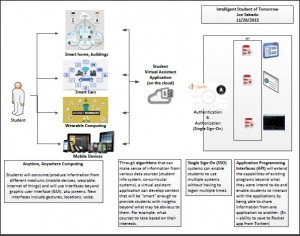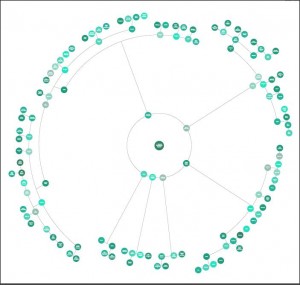I once read a line related to application development that goes something like this: “We (application/web developers) design and build for end-users, and we are not the end-users.” One of the biggest mistakes IT folks commit, which I’ve certainly been guilty of, is designing products and services for ourselves rather than the end-users. It’s too easy to get caught in this trap of creating for ourselves when we never leave the comfort of the office and do not understand those who will use the systems we build. To build effective systems, IT folks need to understand their end-users, those who will either benefit from the IT products/services provided or, unfortunately, will suffer the daily consequences of using systems that are either ineffective or inflict physical/mental pain. If you think I’m over-dramatic with the last sentence, imagine using a system that requires the mouse to scroll up and down web pages hundreds of times daily. After a while, you’ll develop carpal tunnel syndrome. Or, what about websites that are not responsive and the width of the page is wider than the size of the screens the users use, which require them to scroll sideways to see the entire page? That could be very frustrating, right? How about websites that are so heavy with graphics that it takes forever to display (yes, there are still folks worldwide who are connected to the internet on slow networks), which leads to frustrations? Developers and designers need to keep end-users in mind when building effective applications that satisfy the needs of the end-users.
For higher ed IT leaders (or IT leaders in any industry), the burden of responsibility to understand those they serve and their needs is even higher because, at the leadership level, they are essentially dealing not only with technology but business, organizational, and cultural transformations. Their leaders influence and drive the quality of services and products IT provides. Consider the following scenario: an IT leader thinks their organization’s role is to “keep the lights on,” and so they pursue a strategy where they don’t pursue innovation and attempt to introduce new ideas, which at times could lead to disruptions in services, are punished. Consider another scenario where an IT leader thinks the cloud, social media, and mobile computing are all fads. So they tell their staff to ignore these fads since they’re wasteful investments.
The scenarios I described above could be more hypothetical. From articles, blogs, etc., and my conversations with other IT leaders, there’s a disconnect between IT and the business units regarding understanding the priorities and how services/products are designed. A big part of this disconnect is the lack of understanding regarding what business users want and need. Without understanding the business needs and the end-users, IT will use technology to drive the business needs rather than business needs defining what technologies are to be used.
How should IT leaders understand their customers/users and their needs? In higher education, I’ve found several ways to do this:
1) Be part of campus strategic planning processes. When IT leaders get involved after technology-related decisions have been made, these decisions often have to be re-visited as factors that are only evident to IT folks may not have been considered. IT leaders must also think like business leaders instead of technologists to frame how their organizations can best address business problems and not just use technology for technology’s sake. The missions of their campus must drive the efforts of IT organizations, so IT leaders need to understand the missions and priorities of their campus.
2) Understand technology trends. IT leaders are often in no position to be technology experts, given their responsibilities as strategists. Still, they should be aware of technology trends impacting their campus and higher education. For example, publications/orgs such as Pew Research, Educause, and Gartner, as well as national higher education organizations from time to time, have articles on future technology trends and technology use of different demographics. Attend conferences, but not only technology conferences. IT leaders also need to attend conferences attended by functional business users. For example, student affairs IT should attend conferences by NASPA and ACPA, the two major student affairs organizations, and conferences for specific functional units like AACRAO for enrollment management departments.
3) Get out of the office and walk around campus. Observe what devices students use as they will probably be ahead of IT organizations, especially for consumer products like social media, mobile computing, and the next wave of computing – the Internet of Things.
4) Get on social media. Some IT folks pridefully tell me, “I am not on social media because it’s a waste of time!” Frankly, I think that’s a misguided way of thinking. IT folks can learn much from the network of other technology and business experts/leaders in higher education and other industries. I follow the healthcare industry because of the similarities between that industry and student affairs. Specifically, the nature of the high-tech/high-touch services must operate.
There are many more ways IT leaders can begin to understand their customers/users, and it’s a continuous process. Technology is evolving faster than ever, but the business challenges/opportunities in higher education driven by the needs of students, the economy, and politics are so dynamic and complex that IT leaders cannot afford to be left behind and fail to understand those they serve.
I once read a line related to application development that goes something like this “we (application/web developers) design and build for end-users, and we are not the end-users.” One of the biggest mistakes IT folks commit, and I’ve certainly been guilty of this, is designing products and services for ourselves rather than the end-users. It’s too easy to get caught in this trap of designing for ourselves when we never leave the comfort of the office and do not understand those who will use the systems we build. To build effective systems, IT folks need to understand their end-users, those who will either benefit from the IT products/services provided or, unfortunately, will suffer the daily consequences of using systems that are either ineffective or inflict physical/mental pain. If you think I’m being over-dramatic with the last sentence, imagine using a system that requires one to have to repetitively use the mouse to scroll up and down web pages hundreds of times a day. After a while, you’ll develop carpal tunnel syndrome. Or, what about websites that are not responsive and the width of the page is wider than the size of the screens the users are using, which require them to scroll sideways to see the entire page? That could be very frustrating, right? How about websites that are so heavy with graphics that it takes forever to display (yes, there are still folks around the world who are connected to the internet on slow networks), which leads to frustrations? Developers and designers need to keep end-users in mind when building effective applications that satisfy the needs of the end-users.
For higher ed IT leaders (or IT leaders in any industry), the burden of responsibility to understand those they serve and their needs are even higher because when at the leadership level, they are essentially dealing not only with technology but business, organizational, and cultural transformations as well. The quality of service and products provided by IT are influenced and driven by their leaders. Consider the following scenario: an IT leader thinks their organization’s role is to “keep the lights on,” and so they pursue a strategy where they don’t pursue innovation and attempt to introduce new ideas, which at times could lead to disruptions in services, are punished. Consider another scenario where an IT leader thinks the cloud, social media, and mobile computing are all fads. So he/she tells their staff to ignore these fads since they’re wasteful investments.
The scenarios I described above are, unfortunately, not hypothetical. From articles, blogs, etc., and my conversations with other IT leaders, there’s a disconnect between IT and the business units when it comes to an understanding of the priorities and/or how services/products are designed. A big part of this disconnect is the lack of understanding regarding what business users want and need. Without understanding the business needs and the end-users, IT will use technology to drive the business needs rather than business needs defining what technologies are to be used.
How should IT leaders begin to understand their customers/users and their needs? In higher education, I’ve found several ways to do this:
1) Be part of campus strategic planning processes. When IT leaders get involved after technology-related decisions have been made, these decisions often have to be re-visited as factors that are only evident to IT folks may not have been considered. IT leaders also need to think like business leaders instead of technologists to frame how their organizations can best address business problems and not just use technology for technology’s sake. The missions of their campus must drive the efforts of IT organizations, so IT leaders need to understand the missions and priorities of their campus.
2) Understand technology trends. IT leaders are often in no position to be technology experts, given their responsibilities as strategists. Still, they should be cognizant of technology trends impacting their campus and higher education. For example, publications/orgs such as Pew Research, Educause, and Gartner, as well as national higher education organizations from time to time, have articles on future technology trends and technology use of different demographics. Attend conferences but not only technology conferences. IT leaders also need to attend conferences attended by functional business users. For example, student affairs IT should attend conferences by NASPA and ACPA, the two major student affairs organizations, and conferences for specific functional units like AACRAO for enrollment management departments.
3) Get out of the office and walk around campus. Observe what devices students are using as they will probably be ahead of IT organizations, especially when it comes to consumer products like social media and mobile computing and the next wave of computing – the internet of things.
4) Get on social media. Some IT folks pridefully tell me, “I am not on social media because it’s a waste of time!” Frankly, I think that’s a misguided way of thinking. IT folks can learn a lot from the network of other technology and business experts/leaders in higher education and other industries. I follow the health care industry because of the similarities between that industry and student affairs. Specifically, the nature of the high-tech/high-touch services must operate.
There are many more ways IT leaders can begin to understand their customers/users, and it’s a continuous process. Technology is evolving faster than ever, but the business challenges/opportunities in higher education driven by the needs of students, the economy, and politics are so dynamic and complex that IT leaders cannot afford to be left behind and fail to understand those they serve.

